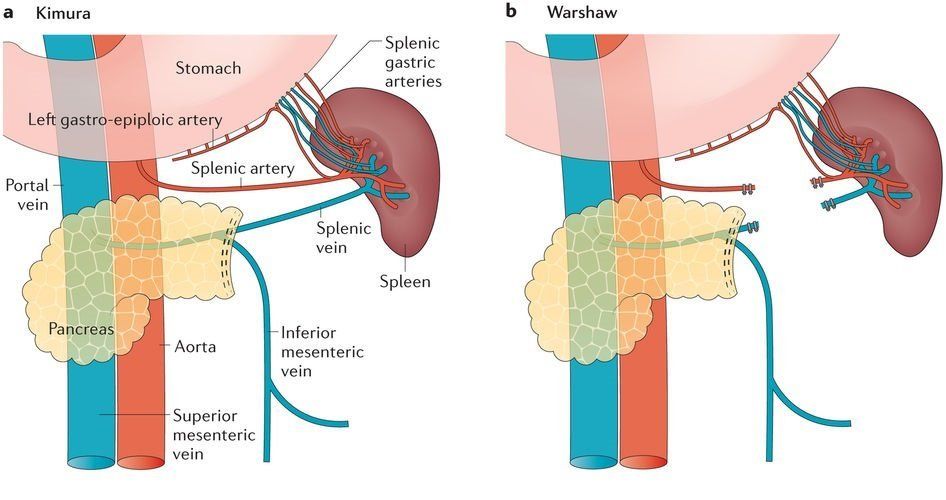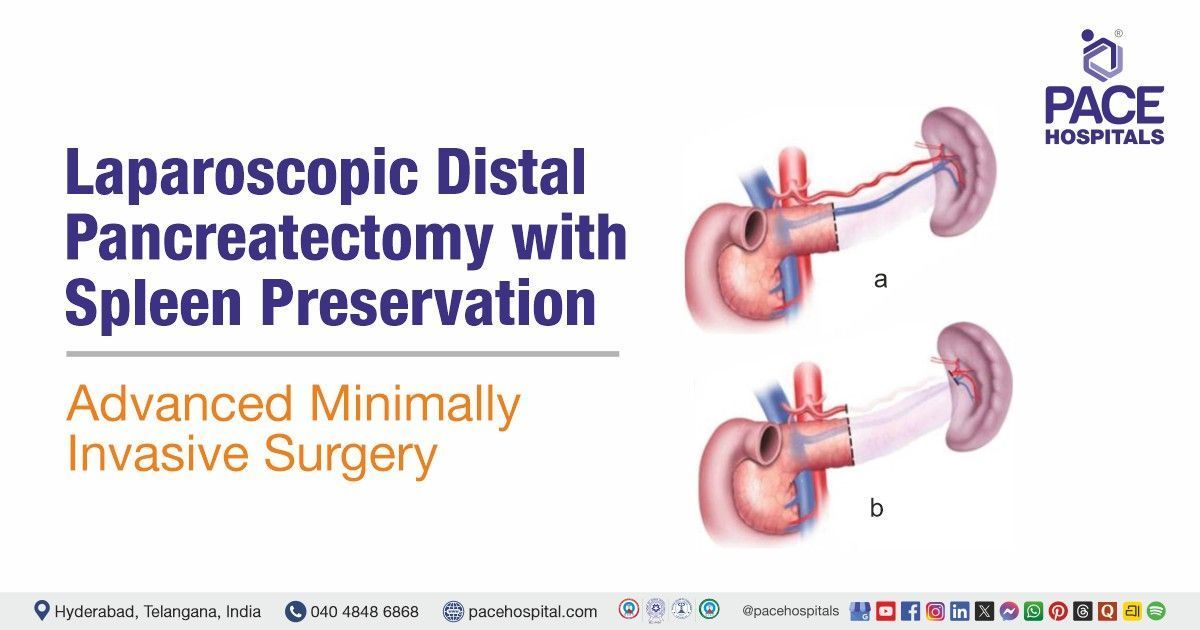Laparoscopic Distal Pancreatectomy with Spleen Preservation | Advanced HPB Surgery
Introduction
The pancreas plays a vital role in digestion and blood sugar regulation, and diseases affecting this organ require highly specialized care. One of the safest and most effective procedures for pancreatic tail and body lesions is the Laparoscopic Distal Pancreatectomy with Spleen Preservation — a minimally invasive surgery that removes the diseased portion of the pancreas while preserving the spleen and its important immune functions.
At PACE Hospitals Hyderabad, our HPB (Hepato-Pancreato-Biliary) and GI surgical team offers this advanced procedure using 3D laparoscopy and precision instruments, ensuring faster recovery, minimal scarring, and excellent long-term outcomes for both benign and early malignant pancreatic diseases.

What Is a Laparoscopic Distal Pancreatectomy?
A distal pancreatectomy involves surgical removal of the left (distal) portion of the pancreas, typically involving the body and tail. When performed laparoscopically, the surgeon uses small keyhole incisions and a high-definition camera to access and remove the diseased part, ensuring minimal trauma to surrounding tissues.
In spleen-preserving distal pancreatectomy, the surgeon carefully preserves the splenic artery and vein (Warshaw or Kimura technique), maintaining spleen viability and immune function.
Why Preserve the Spleen?
The spleen is an essential organ for immunity, helping the body fight bacterial infections and filter abnormal blood cells. Removing it (splenectomy) may increase the risk of life-threatening infections, especially in young or immunocompromised patients.
Thus, whenever possible, spleen-preserving surgery is preferred, especially for:
- Benign pancreatic cysts or tumors (e.g., mucinous cystadenoma, serous cystadenoma)
- Low-grade malignant lesions
- Neuroendocrine tumors
- Chronic pancreatitis involving the distal pancreas
Indications for Laparoscopic Distal Pancreatectomy
PACE Hospitals’ surgical experts recommend this procedure in the following conditions:
- Pancreatic cystic neoplasms (mucinous cystadenoma, serous cystadenoma)
- Pancreatic neuroendocrine tumors
- Solid pseudopapillary tumor of the pancreas
- Chronic pancreatitis localized to body/tail
- Intraductal papillary mucinous neoplasms (IPMN)
- Pancreatic trauma or injury
- Benign or low-grade malignant lesions of the distal pancreas
For malignant tumors with vascular or lymphatic involvement, a distal pancreatectomy with splenectomy may still be required.
Preoperative Evaluation at PACE Hospitals
Before surgery, every patient undergoes a detailed assessment by the HPB surgical and gastroenterology teams to determine operability and optimize outcomes.
Diagnostic Tests May Include:
- Contrast-enhanced CT or MRI of the abdomen
- Endoscopic Ultrasound (EUS) with biopsy
- PET-CT (for tumor staging if required)
- Liver and kidney function tests
- Tumor markers (CA 19-9, CEA)
- Cardiac and anesthetic evaluation
Patients are also counseled on the nature of the surgery, expected recovery, and the benefits of spleen preservation.
The Laparoscopic Surgical Procedure
Step-by-Step Overview:
- Anesthesia and Positioning: The patient is placed under general anesthesia and positioned in a slight left lateral decubitus position to optimize exposure.
- Port Placement: Several small incisions (5–10 mm) are made for laparoscopic ports through which instruments and a camera are inserted.
- Mobilization of the Pancreas: The surgeon gently separates the pancreas from surrounding tissues and the splenic vessels using energy devices.
- Identification of Splenic Vessels: In spleen-preserving techniques, splenic artery and vein are meticulously dissected and preserved (Kimura technique). Alternatively, in the Warshaw technique, short gastric vessels maintain splenic blood flow when main splenic vessels are divided.
- Division of the Pancreas: The distal pancreas is divided using a laparoscopic stapler, ensuring hemostasis and sealing of the pancreatic duct.
- Specimen Retrieval: The resected portion is placed in a retrieval bag and removed through a small incision.
- Drain Placement: A surgical drain may be placed near the pancreas to monitor for postoperative leakage.
- Closure: Small incisions are closed using absorbable sutures, leaving minimal scarring.
Postoperative Recovery and Care
At PACE Hospitals, postoperative care focuses on early mobilization, pain control, and nutritional recovery.
- Hospital Stay: Typically 3–5 days
- Oral intake: Resumed within 1–2 days post-surgery
- Drain removal: Usually after 3–5 days once output is minimal
- Return to work: Within 2–3 weeks
Recovery Benefits of Laparoscopic Surgery:
- Smaller incisions and minimal scarring
- Reduced postoperative pain
- Faster discharge
- Lower risk of infection
- Better cosmetic results
Possible Complications and Their Management
Although rare, certain complications may occur after distal pancreatectomy:
| Complication | Description | PACE Hospitals Approach |
|---|---|---|
| Pancreatic fistula | Leakage of pancreatic fluid | Managed conservatively or with drain adjustment |
| Bleeding | From pancreatic vessels | Controlled laparoscopically using advanced hemostatic tools |
| Infection/Abscess | Postoperative collection | Managed with antibiotics or drainage |
| Splenic infarction | Rare after spleen preservation | Detected on follow-up imaging and treated accordingly |
With modern equipment, advanced energy devices, and intraoperative imaging, such complications are minimized at PACE Hospitals.
Cost of Laparoscopic Distal Pancreatectomy with Spleen Preservation at PACE Hospitals
| Type of Procedure | Estimated Cost (INR) | Estimated Cost (USD) |
|---|---|---|
| Laparoscopic Distal Pancreatectomy (Spleen-Preserving) | ₹2,20,000 – ₹3,50,000 | $2,600 – $4,200 |
| Distal Pancreatectomy with Splenectomy | ₹2,50,000 – ₹3,80,000 | $3,000 – $4,600 |
| Preoperative Tests & Imaging | ₹15,000 – ₹30,000 | $180 – $350 |
| Follow-up and Postoperative Care | ₹5,000 – ₹10,000 | $60 – $120 |
Cashless insurance and EMI options are available at PACE Hospitals for eligible patients.
Why Choose PACE Hospitals Hyderabad for HPB Surgery?
- Specialized HPB & Liver Transplant Unit with expert surgeons trained in advanced laparoscopic and robotic techniques
- Integrated care from preoperative assessment to postoperative rehabilitation
- 24×7 multidisciplinary support — gastroenterology, hepatology, oncology, and critical care
- State-of-the-art 4K laparoscopy systems ensuring surgical precision
- Minimal pain, faster recovery, and shorter hospital stay
- Proven success in pancreatic, liver, and bile duct surgeries across India
FAQs on Laparoscopic Distal Pancreatectomy with Spleen Preservation
What are the benefits of laparoscopic surgery compared to open surgery?
Laparoscopy offers smaller incisions, faster recovery, less pain, and minimal hospital stay compared to open procedures.
Who needs a distal pancreatectomy?
Patients with cystic pancreatic tumors, neuroendocrine tumors, or chronic pancreatitis affecting the distal pancreas benefit from this surgery.
How long does recovery take after laparoscopic distal pancreatectomy?
Most patients resume normal activity within 2–3 weeks with complete internal healing in 6–8 weeks.
What are the potential risks or complications?
Minor risks include pancreatic leak, infection, or bleeding, all of which are effectively managed with advanced postoperative care.
How much does laparoscopic distal pancreatectomy cost in Hyderabad?
At PACE Hospitals, Hyderabad, the laparoscopic distal pancreatectomy typically costs ₹2.2 – ₹3.5 lakhs ($2,600 – $4,200) depending on case complexity and room category.
What is a laparoscopic distal pancreatectomy?
It is a minimally invasive surgery that removes the body and tail of the pancreas while preserving the spleen whenever possible.
Why preserve the spleen during this surgery?
The spleen plays an important role in immunity. Preserving it prevents infections and improves postoperative recovery.
What is the difference between Kimura and Warshaw techniques?
Both preserve the spleen. The Kimura technique preserves splenic vessels, while Warshaw divides them but maintains spleen blood flow through short gastric vessels.
Can this surgery cure pancreatic cancer?
It can treat early-stage localized pancreatic tumors; however, advanced cancers may require additional chemotherapy or radiotherapy.
Why choose PACE Hospitals for pancreatic surgery?
PACE Hospitals’ HPB team provides expert, minimally invasive pancreatic surgery with high success rates, faster recovery, and personalized patient care.
Share on
Request an appointment
Fill in the appointment form or call us instantly to book a confirmed appointment with our super specialist at 04048486868











